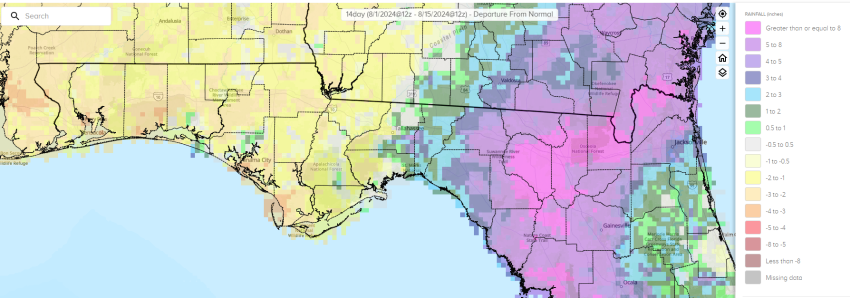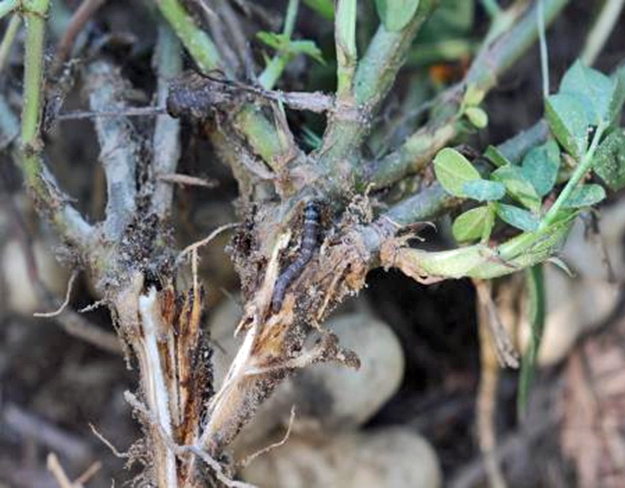Ethan Carter, UF/IFAS Extension Regional Row Crop IPM Agent & Mark Mauldin, UF/IFAS Extension Washington County
Maturity Update
The Tracker below shows the number of adjusted Growing Degree Days (aGDDs) accumulated by 80 fictional fields (8 locations x 10 planting dates) as of 8/15/24. Real temperature and rainfall data from each location is used as well as common soil types for the areas (Jay – sandy loam, Marianna – loamy sand, Marianna Irrigated – sand, Monticello – loamy sand, Live Oak and Bronson – sand). Peanuts reach physiological maturity after the accumulation of approximately 2500 Growing Degree Days and the Tracker quantifies their progress. Use the Tracker to approximate how your fields are progressing by following the fields on the Tracker that are the most similar to yours in terms of planting date, location and irrigation status. If the aGDD value shown for your field is black (under 2300), it’s probably not time to dig. If it’s yellow (between 2300 and 2500), you’re getting close; it’s time to pull samples and pod-blast to fine tune your harvest timing. Orange (2500+) means it’s almost certainly time to harvest, but pod-blasting is always the best way to know for sure.
For more precise tracking of your fields, go to PeanutFARM.org and set up your fields in the system. You will be able to enter field specific rainfall/irrigation data and soil type. Temperature data will come from the closest FAWN weather station. If you are interested in setting up your own fields on PeanutFARM.org don’t hesitate to contact me for assistance.
aGDD Tracker for the Florida Peanut Producing Region – 8/15/24 edition
The aGDD Tracker is compiled from data generated by PeanutFARM.org. The dark blue bars in the cells with the aGDD values indicates progress towards 2500 aGDDs. The bar extends to the right as aGDDs are accumulated. The entire cell will be dark blue when a field has accumulated 2500 aGDDs. It is recommended that fields be sampled and exact days-to-harvest be determined via pod-blasting once a field reaches 2300 aGDDs.
–
It takes heat and moisture for peanuts to mature. Goodness knows we’ve had plenty heat and where moisture has been adequate, whether from rain or irrigation, peanut maturity is progressing rapidly. Based on the rule of thumb 140 calendar days to mature a peanut crop, and the fact that it takes an average of 2500 aGDDs to mature a crop, you would expect to see an average of about 18 aGDDs accumulated each calendar day. Across all locations and planting dates shown in the aGDD Tracker the average thus far is 19.7 aGDDs per calendar day. As you would expect, irrigated fields are progressing faster (21.6 aGDDs per calendar day) than the rainfed fields (18.5 aGDDs per calendar day). At 21.6 aGDDs per calendar day a crop could theoretically mature in 115 days. Please don’t bank on that exact number (the amount of irrigation the fictional fields shown on the aGDD Tracker is way more than most would irrigate in real life). The point is that under ideal conditions a crop can mature very rapidly. Conversely, if the recent dry conditions persist in the Central and Western Panhandle (see figure 1 & 2 below) you will see the accumulation of aGDDs has slowed considerably in rain-fed fields. Environmental conditions (drought, cool night time temperatures late in the growing season, pest/disease pressure, etc.) can have a tremendous impact on how fast a crop matures, so that’s why it is important to use tools like the aGDD Tracker to help you estimate progress, and why it is always recommended to sample and pod-blast when you think a field is getting close to maturity.

Figure 1) Precipitation Totals for the 14 days prior to August 14, 2024. From: water.noaa.gov

Figure 2) Departure from normal precipitation amounts for the 14 days prior to August 15,2024. From: water.noaa.gov
–
Pest Update
While the peanuts may not be loving the hot and dry conditions the Central and Western Panhandle have been experiencing for the past few weeks, lesser cornstalk borers (LCB) think the weather has been pretty awesome. It is very important to scout diligently for LCB. Since they feed inside the stems and pods of peanut plants, they can be more difficult to spot than foliage feeding caterpillars, but if an infestation goes unnoticed (and untreated) LCB damage can have a huge impact on yield. According to Dr. Mark Abney, UGA peanut entomologist, “fields should be scouted soon and scouted every week to determine if LCB is present and if an insecticide application is needed. […] When scouting for LCB, be certain to check plants randomly. Stopping to check only plants in skips or those with wilted leaves will bias the count and could result in an unnecessary insecticide application. Finding a live LCB larva at 3 out of 10 stops in a field (checking 3 feet of row at each stop) is enough to warrant a spray.”
If an insecticide application is needed for LCB control, chlorantraniliprole (Prevathon and Vantacor) and novaluron (Diamond) are the only two recommended chemistries. Other products are not effective and/or will increase the risk of flaring spider mites – another pest that loves hot & dry conditions. The use rates for the two chlorantraniliprole products are very different, so be sure you know which you are using. The label rate for Vantacor is 1.2 -2.5oz/ac (season total of no more than 5.1oz.), while the Prevathon rate 14-20oz/ac (season total of no more than 60 oz.). Both products permit up to 4 applications per year with at least 5 days between applications and have a 1 day preharvest interval. Diamond is recommended at 6-12oz/ac (season total of no more than 36 oz; 3 applications at least 7 days apart). Diamond has a 28 day preharvest interval, which is important to consider as we get later in the season. The chlorantraniliprole products will take effect faster than novaluron but both are effective at controlling LCB.
Use the following link for more information on LCB: Lesser Corn Stalk Borers
- Peanut Maturity Update – 10/9/25 - October 10, 2025
- Fall Can be a Great Time for Vegetation Management - October 3, 2025
- Peanut Maturity Update – 9/25/25 Edition - September 26, 2025

